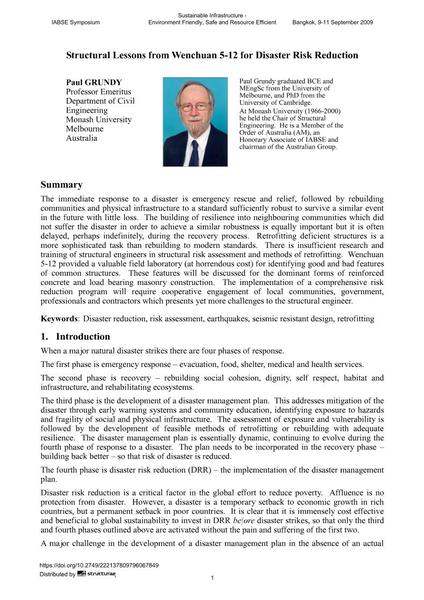Structural Lessons from Wenchuan 5-12 for Disaster Risk Reduction

|
|
|||||||||||
Bibliographic Details
| Author(s): |
Paul Grundy
|
||||
|---|---|---|---|---|---|
| Medium: | conference paper | ||||
| Language(s): | English | ||||
| Conference: | IABSE Symposium: Sustainable Infrastructure - Environment Friendly, Safe and Resource Efficient, Bangkok, Thailand, 9-11 September 2009 | ||||
| Published in: | IABSE Symposium Bangkok 2009 | ||||
|
|||||
| Page(s): | 11-18 | ||||
| Total no. of pages: | 8 | ||||
| Year: | 2009 | ||||
| DOI: | 10.2749/222137809796067849 | ||||
| Abstract: |
The immediate response to a disaster is emergency rescue and relief, followed by rebuilding communities and physical infrastructure to a standard sufficiently robust to survive a similar event in the future with little loss. The building of resilience into neighbouring communities which did not suffer the disaster in order to achieve a similar robustness is equally important but it is often delayed, perhaps indefinitely, during the recovery process. Retrofitting deficient structures is a more sophisticated task than rebuilding to modern standards. There is insufficient research and training of structural engineers in structural risk assessment and methods of retrofitting. Wenchuan 5-12 provided a valuable field laboratory (at horrendous cost) for identifying good and bad features of common structures. These features will be discussed for the dominant forms of reinforced concrete and load bearing masonry construction. The implementation of a comprehensive risk reduction program will require cooperative engagement of local communities, government, professionals and contractors which presents yet more challenges to the structural engineer. |
||||
| Keywords: |
earthquakes risk assessment retrofitting Disaster reduction seismic resistant design
|
||||
